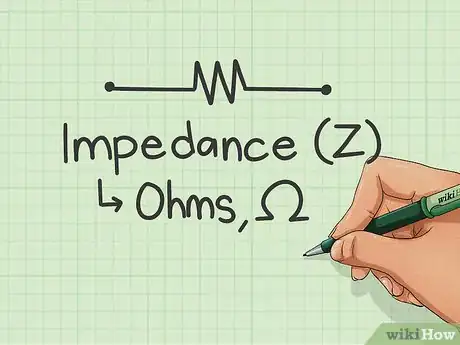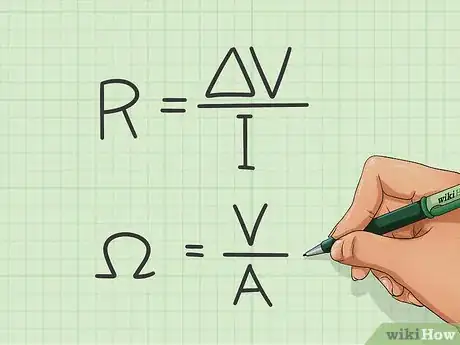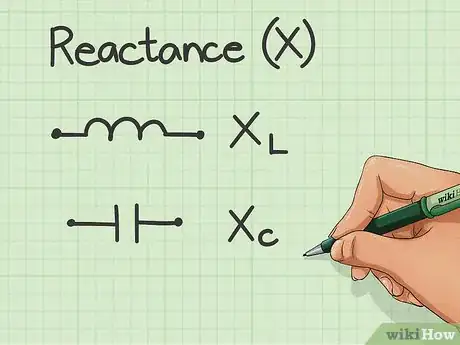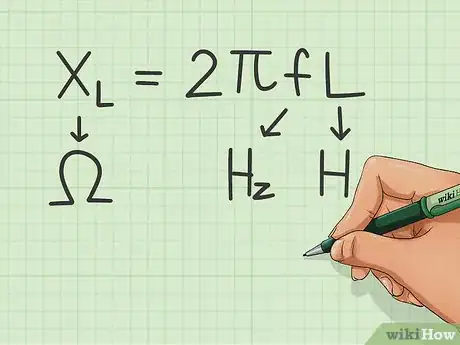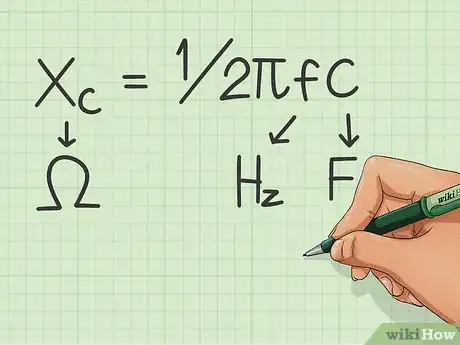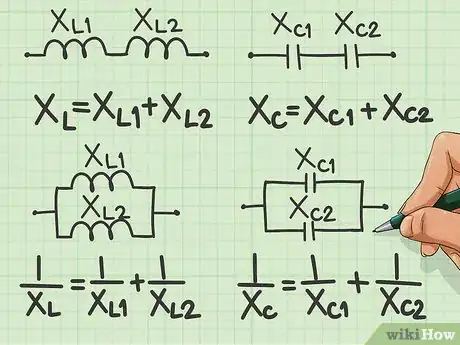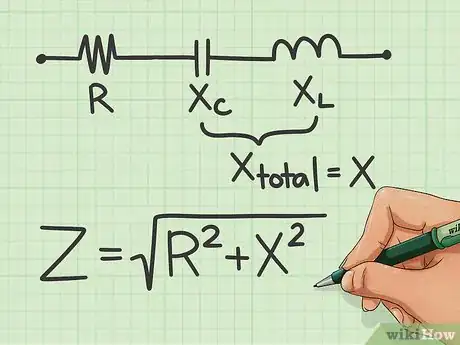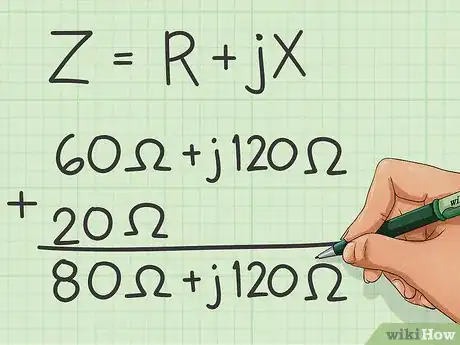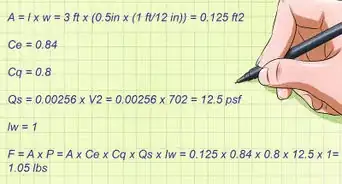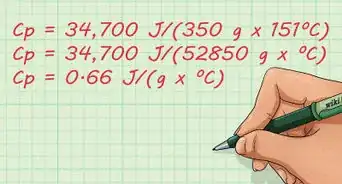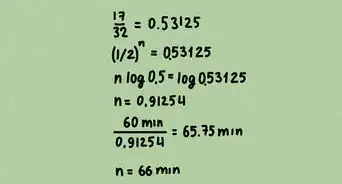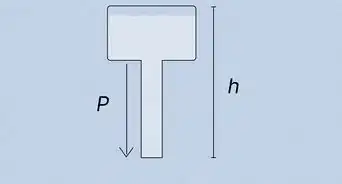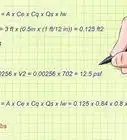This article was co-authored by Bess Ruff, MA. Bess Ruff is a Geography PhD student at Florida State University. She received her MA in Environmental Science and Management from the University of California, Santa Barbara in 2016. She has conducted survey work for marine spatial planning projects in the Caribbean and provided research support as a graduate fellow for the Sustainable Fisheries Group.
There are 12 references cited in this article, which can be found at the bottom of the page.
wikiHow marks an article as reader-approved once it receives enough positive feedback. This article received 18 testimonials and 86% of readers who voted found it helpful, earning it our reader-approved status.
This article has been viewed 765,384 times.
Impedance is the opposition of a circuit to alternating current. It's measured in ohms. To calculate impedance, you must know the value of all resistors and the impedance of all inductors and capacitors, which offer varying amounts of opposition to the current depending on how the current is changing in strength, speed, and direction. You can calculate impedance using a simple mathematical formula.
Formula Cheatsheet
- Impedance Z = R or XLor XC(if only one is present)
- Impedance in series only Z = √(R2 + X2) (if both R and one type of X are present)
- Impedance in series only Z = √(R2 + (|XL - XC|)2) (if R, XL, and XC are all present)
- Impedance in any circuit = R + jX (j is the imaginary number √(-1))
- Resistance R = ΔV / I
- Inductive reactance XL = 2πƒL = ωL
- Capacative reactance XC = 1 / 2πƒC = 1 / ωC
Steps
Calculating Resistance and Reactance
-
1Define impedance. Impedance is represented with the symbol Z and measured in Ohms (Ω). You can measure the impedance of any electrical circuit or component. The result will tell you how much the circuit resists the flow of electrons (the current). There are two different effects that slow the current, both of which contribute to the impedance:[1]
- Resistance (R) is the slowing of current due to effects of the material and shape of the component. This effect is largest in resistors, but all components have at least a little resistance.
- Reactance (X) is the slowing of current due to electric and magnetic fields opposing changes in the current or voltage. This is most significant for capacitors and inductors.
-
2Review resistance. Resistance is a fundamental concept in the study of electricity. You'll see it most often in Ohm's law: ΔV = I * R.[2] This equation lets you calculate any of these values if you know the other two. For instance, to calculate resistance, write the formula as R = ΔV / I. You can also measure resistance easily, using a multimeter.
- ΔV is the voltage, measured in Volts (V). It is also called the potential difference.
- I is the current, measured in Amperes (A).
- R is the resistance, measured in Ohms (Ω).
Advertisement -
3Know which type of reactance to calculate. Reactance only occurs in AC circuits (alternating current). Like resistance, it is measured in Ohms (Ω). There are two types of reactance, which occur in different electrical components:
- Inductive reactance XL is produced by inductors, also called coils or reactors. These components create a magnetic field that opposes the directional changes in an AC circuit.[3] The faster the direction changes, the greater the inductive reactance.
- Capacitive reactance XC is produced by capacitors, which store an electrical charge. As current flows in an AC circuit changes direction, the capacitor charge and discharges repeatedly. The more time the capacitor has to charge, the more it opposes the current.[4] Because of this, the faster the direction changes, the lower the capacitive reactance.
-
4Calculate inductive reactance. As described above, inductive reactance increases with the rate of change in the current direction, or the frequency of the circuit. This frequency is represented by the symbol ƒ, and is measured in Hertz (Hz). The full formula for calculating inductive reactance is XL = 2πƒL, where L is the inductance measured in Henries (H).[5]
- The inductance L depends on the characteristics of the inductor, such as the number of its coils.[6] It is possible to measure the inductance directly as well.
- If you're familiar with the unit circle, picture an AC current represented with this circle, with one full rotation of 2π radians representing one cycle. If you multiply this by ƒ measured in Hertz (units per second), you get a result in radians per second. This is the circuit's angular velocity, and can be written as a lower-case omega ω. You might see the formula for inductive reactance written as XL=ωL[7]
-
5Calculate capacitive reactance. This formula is similar to the formula for inductive reactance, except capacitive reactance is inversely proportional to the frequency. Capacitive reactance XC = 1 / 2πƒC.[8] C is the capacitance of the capacitor, measured in Farads (F).
- You can measure capacitance using a multimeter and some basic calculations.
- As explained above, this can be written as 1 / ωC.
Calculating Total Impedance
-
1Add resistances in the same circuit. Total impedance is simple if the circuit has several resistors, but no inductors or capacitors. First, measure the resistance across each resistor (or any component with resistance), or refer to the circuit diagram for the labeled resistance in ohms (Ω). Combine these according to how the components are connected:[9]
- Resistors in series (connected end to end along one wire) can be added together. The total resistance R = R1 + R2 + R3...
- Resistors in parallel (each on a different wire that connects to the same circuit) are added as their reciprocals. To find the total resistance R, solve the equation 1/R = 1 / R1 + 1 / R2 + 1 / R3 ...
-
2Add similar reactance values in the same circuit. If there are only inductors in the circuit, or only capacitors, the total impedance is the same as the total reactance. Calculate it as follows:[10]
- Inductors in series: Xtotal = XL1 + XL2 + ...
- Capacitors in series: Ctotal = XC1 + XC2 + ...
- Inductors in parallel: Xtotal = 1 / (1/XL1 + 1/XL2 ...)
- Capacitors in parallel: Ctotal = 1 / (1/XC1 + 1/XC2 ...)
-
3Subtract inductive and capacitive reactance to get total reactance. Because one of these effects increases as the other decreases, these tend to cancel each other out. To find the total effect, subtract the smaller one from the larger.[11]
- You will get the same result from the formula Xtotal = |XC - XL|
-
4Calculate impedance from resistance and reactance in series. You can't just add the two together, because the two values are "out of phase." This means that both values change over time as part of the AC cycle, but reach their peaks at different times.[12] Fortunately, if all of the components are in series (i.e. there is only one wire), we can use the simple formula Z = √(R2 + X2).[13]
-
5Calculate impedance from resistance and reactance in parallel. This is actually a general way to express impedance, but it requires an understanding of complex numbers. This is the only way to calculate the total impedance of a circuit in parallel that includes both resistance and reactance.
- Z = R + jX, where j is the imaginary component: √(-1). Use j instead of i to avoid confusion with I for current.
- You cannot combine the two numbers. For example, an impedance might be expressed as 60Ω + j120Ω.
- If you have two circuits like this one in series, you can add the real and imaginary components together separately. For example, if Z1 = 60Ω + j120Ω and is in series with a resistor with Z2 = 20Ω, then Ztotal = 80Ω + j120Ω.
Community Q&A
-
QuestionWhat does the j stand for in an impedance calculation?
 wikiHow Staff EditorThis answer was written by one of our trained team of researchers who validated it for accuracy and comprehensiveness.
wikiHow Staff EditorThis answer was written by one of our trained team of researchers who validated it for accuracy and comprehensiveness.
Staff Answer wikiHow Staff EditorStaff AnswerThe j stands in for the imaginary number √(-1). Normally you would use i for this, but j is used in impedance calculations to avoid confusion with I for current.
wikiHow Staff EditorStaff AnswerThe j stands in for the imaginary number √(-1). Normally you would use i for this, but j is used in impedance calculations to avoid confusion with I for current. -
QuestionHow do I calculate line impedance?
 wikiHow Staff EditorThis answer was written by one of our trained team of researchers who validated it for accuracy and comprehensiveness.
wikiHow Staff EditorThis answer was written by one of our trained team of researchers who validated it for accuracy and comprehensiveness.
Staff Answer wikiHow Staff EditorStaff AnswerLine impedance is the ratio of complex line voltage to complex line current. You can calculate it with the following equation: Z(z) = V(z)/I(z).
wikiHow Staff EditorStaff AnswerLine impedance is the ratio of complex line voltage to complex line current. You can calculate it with the following equation: Z(z) = V(z)/I(z). -
QuestionHow do I calculate the impedance of the coil connected in series with the capacitor?
 Community AnswerIf the coil has a resistance, then treat it as an LCR circuit. Z = [(Xc-XL)^2 + R]^0.5, where Z is the impedence, Xc is reactance of the capacitor which is equal to 1/(wC), w being the angular frequency and C being capacitance. XL is reactance of the coil which is equal to wL, L being the inductance of the coil, and R is resistance of the coil. Put R = 0 in case the coil has no resistance.
Community AnswerIf the coil has a resistance, then treat it as an LCR circuit. Z = [(Xc-XL)^2 + R]^0.5, where Z is the impedence, Xc is reactance of the capacitor which is equal to 1/(wC), w being the angular frequency and C being capacitance. XL is reactance of the coil which is equal to wL, L being the inductance of the coil, and R is resistance of the coil. Put R = 0 in case the coil has no resistance.
References
- ↑ http://www.allaboutcircuits.com/vol_2/chpt_5/1.html
- ↑ http://www.physicsclassroom.com/class/circuits/Lesson-3/Ohm-s-Law
- ↑ http://www.electronics-tutorials.ws/accircuits/ac-inductance.html
- ↑ http://www.learnabout-electronics.org/ac_theory/reactance62.php
- ↑ http://www.learnabout-electronics.org/ac_theory/reactance61.php
- ↑ http://www.learnabout-electronics.org/ac_theory/inductors02.php#backemf
- ↑ https://www.allaboutcircuits.com/textbook/alternating-current/chpt-3/ac-inductor-circuits/
- ↑ http://www.learnabout-electronics.org/ac_theory/reactance62.php
- ↑ http://physics.bu.edu/py106/notes/Circuits.html
- ↑ http://www.wilsonware.com/electronics/capacitive_reactance.htm
- ↑ http://artsites.ucsc.edu/ems/music/tech_background/z/impedance.html
- ↑ http://www.allaboutcircuits.com/vol_2/chpt_5/1.html
- ↑ https://www.nde-ed.org/GeneralResources/Formula/ECFormula/Impedance/ECImpedance.htm
- ↑ http://www.electronics-tutorials.ws/accircuits/ac-inductance.html
- ↑ http://www.learnabout-electronics.org/ac_theory/impedance71.php
About This Article
To calculate impedance, calculate the resistance and reactance of the circuit, then label resistance as R and reactance as X. Square both R and X, and add the two products together. Take the square root of the sum of the squares of R and X to get impedance. Display the answer in ohms. To learn how to calculate resistance and reactance, read on!
